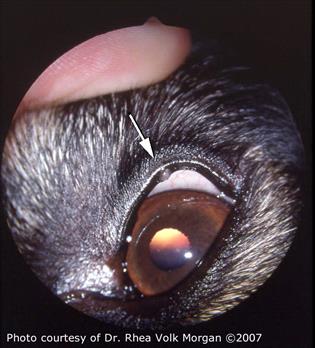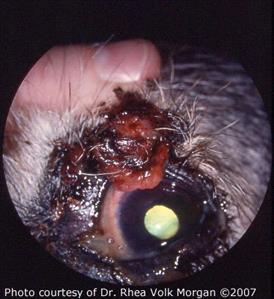Meibomian Gland Adenoma, Eyelid, Dog (Photograph)

This small sebaceous adenoma (white arrow) in a 7-year-old collie-x dog was an incidental finding. Courtesy of Dr. Rhea Volk Morgan.
The eyelids of dogs, cats and people contain Meibomian glands. These tiny oil glands are a type of sebaceous glands. They produce a secretion called tear film that helps keep the eyes moist by lubricating them. Dozens of these glands are in each eyelid.
Sometimes little bumps – overgrowths of blocked oil from the Meibomian glands - form into tumors. Cats can get them too, but not as often as dogs. They are usually benign, seen in older dogs, and some of them will just go away on their own. You don’t need any special equipment to see them. They can be inside or outside the eyelid. Benign tumors grow slowly. They can be uncomfortable if they scratch the cornea or don’t allow the eye to shut correctly. Also, they can become irritated and cause pain. A few masses are just a cosmetic issue, but you have to keep an eye on them (no pun intended) to see if they grow. If the tumor is large enough, it can cause problems blinking or damage to the eye itself, and in severe cases can become ulcerated.
Meibomian masses are the most common eyelid tumor of middle-aged and older dogs; the average age to get them is over 8.
We do not know why dogs get eyelid tumors, nor can we prevent them. We can check their eyes regularly to look for signs of any problem.
Cancer
Usually these eyelid issues are benign but sometimes the masses starting from these same glands are sebaceous adenocarcinomas, a type of cancer, that is capable of spreading into the lymph nodes. Other malignant eyelid tumors can come from other types of cells, too. They are less common in dogs than the benign Meibomian adenomas but it’s not always possible to tell them apart just by looking at them.
Sebaceous Adenoma, Eyelid, Dog (Photograph)

This large sebaceous adenoma ruptured into the surrounding tissue and caused the cutaneous surface of the lid to ulcerate. Courtesy of Dr. Rhea Volk Morgan.
These tumors behave in a benign fashion and grow slowly. Generally, they are pigmented (colored), some are more so than others. Sometimes there is swelling around it. Rupture of the material into the surrounding conjunctiva (the mucous membrane that lines the inner surface of the eyelids) causes an inflammatory response that can create apparent rapid “growth” of the mass. Sebaceous adenocarcinomas are rare. They may clinically appear similar to benign adenomas and behave in a benign manner but are not technically benign. If you have any suspicion that an eyelid growth is changing, see your veterinarian.
Treatment
Oftentimes the best treatment plan for a benign tumor is to leave it alone, but it should be seen by your veterinarian to determine if it needs more than that. If it doesn’t bother your dog, or grow larger, it can likely be left alone. If the mass looks like a small whitehead and the dog is not annoyed, your veterinarian will probably tell you to come back in only if it gets larger.
If it grows or is malignant, the mass will need to be removed surgically, and there are several ways to do so. The surgical approach depends on the details and location of the mass.
With traditional surgery and general anesthesia, the meibomian gland is removed along with the mass. Sutures will close the incision.
Laser surgery can be used, which leaves a bloodless incision. A shield will protect the cornea and towels will protect the dog’s skin. Depending on the specifics of the mass, a local can be used instead of general anesthesia. Sutures are needed with laser surgery.
Cryosurgery freezes tissue so that it drops off and also leaves a bloodless site. It can sometimes remove small cysts or clean out a smaller mass after surgery on a larger mass. Cryosurgery helps prevent regrowth due to the cell destruction it causes. Sutures are not needed.
If your pet is too old to risk anesthesia, lubricating eyedrops can be given to make the eyelid slide over the cornea more easily. It likely won’t be as comfortable as after a mass is removed, but it can help the dog be more comfortable.
Your dog will likely need to wear an e-collar to prevent them from irritating the incision. No matter what method is used to remove the Meibomian eyelid tumor, it’s possible you might notice some blood around the eyes for the next few days. The swelling from surgery should go down in about a week.
Recurrence
Only about 10% of these eyelid tumors recur. If they do, you’ll most likely see them return within the following 6 months, so keep checking for them every once in a while.